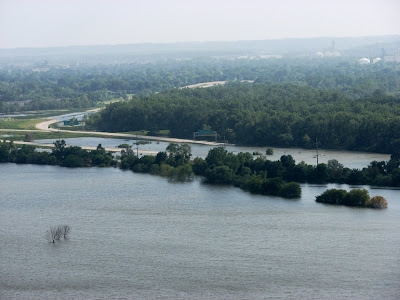You may be forgiven for not knowing much about the catastrophic Missouri River flooding that has caused billions of dollars in damage, closed interstate highways for months, and driven thousands of people from their homes. The only time it garnered national attention was when it appeared that a local nuclear power plant might be damaged by floodwaters. A cynical person might wonder if the national media was hoping for a dangerous radiation leak, in order to highlight the risks of nuclear energy. Fortunately, no catastrophe resulted from that incident, since the plant was already shut down.
 |
| Flooded farms and businesses |
It all started in early June, when the Army Corps of Engineers anounced that it would be increasing water releases from dams located upstream, in Montana and South Dakota, to up to three times the normal flows. The releases were needed to accommodate heavy rainfall upstream, as well as higher than normal snowmelt. Residents of affected areas were warned to evacuate their homes, including some of my family members who live six miles from the river (their location was threatened by nearby creeks backing up since normal flows into the Missouri would be prevented by the high water levels). Evacuees were instructed to prepare for months of living away from their homes, and indeed, the high water is just now beginning to recede. As you might expect, the prospect of abandoning one's home for several months is disruptive to say the least. Many homeowners removed all furnishings from their homes, as well as ripping out drywall and carpet on lower levels, to minimize mold and damage caused by standing water.
In addition to the thousands of individual victims of the flooding, cities and towns along the Missouri have been forced to spend millions of dollars shoring up levees that were never intended to hold up under months of elevated water levels. Parks and businesses have closed due to being cut off by floodwaters. The Omaha airport, Eppley Airfield, has fortified surrounding levees and drilled over 70 wells from which to pump out groundwater that threatens its runways. The City of Omaha has installed several gigantic pumps to empty water from storm sewers over its floodwall into the river, in order to prevent widespread street flooding.
 |
| Pumps moving water from storm sewers into the river in Omaha |
Interstate 29 has been closed since June north and south of Council Bluffs, Iowa, necessating detours of up to 30 miles for area traffic. Missouri River crossings at several Nebraska, Missouri, and Iowa towns have also been closed, causing great inconvenience and financial harm to businesses located near the crossings.
 |
| Interstate 29 north of Council Bluffs, Iowa |
Now comes the news that FEMA has denied individual assistance to flood victims in Iowa. According to the linked article, at least 582 homes must be destroyed in order for areas to qualify for disaster assistance. Most likely there will be a number greatly in excess of that, but since there are many homes still inundated which are currently inaccessable, final assessments can't be completed in a timely manner.
Granted, we never had national news stories of people standing on their roofs, crying out for help from the government. Instead, we had neighbors helping neighbors and a can-do, self-sufficient attitude. Almost anyone with a pickup truck was offering help to those forced from their homes. We had thousands of volunteers filling millions of sandbags to reinforce our levees, and responsible precautions that have saved lives and minimized flood damage. Nevertheless this disaster, directly caused by actions of federal agencies, has resulted in untold expense to individuals, businesses, states, and municipalities. Why now is our request for assistance denied by the very people who caused it?

2 comments:
I read it, as you asked. It's a great piece.
Thank you David. It just seems like we are not getting any national attention here for what is really a huge tragedy.
Post a Comment